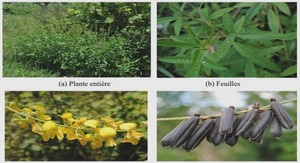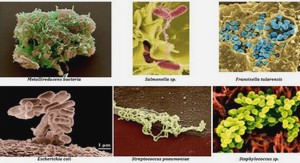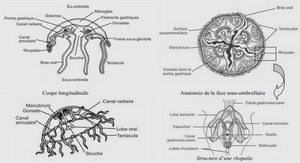Photophysique des molécules polycycliques aromatiques hydrogénées d’intérêt interstellaire avec l’expérience PIRENEA
The components of the interstellar matter
The ISM consists of gas (99%) and grain particles (1%) and contains about 10% of the mass of our galaxy. Its chemical composition is dominated by hydrogen (70.4% in mass) and helium (28.1%), whereas heavier elements (C, N, O, Fe, Mg, Si…) contribute for the remaining 1.5%.
The gas component
The interstellar gas is organised in a variety of phases characterised by different temperatures, hydrogen densities and ionisation states. Early models, McKee & Ostriker (1977), classify the ISM into three phases: the cold neutral medium (CNM), the warm ionised or warm neutral medium (WIM or WNM) and the hot ionised medium (HIM), which is sometimes referred to as the intercloud medium or the coronal gas. These phases appear to contain a variety of cloud types, spanning a wide range of physical and chemical conditions. The table reported in Fig. 1.1 summarises the classification of the different cloud types proposed by Snow & McCall (2006). We can distinguish: • Diffuse clouds: these are the most tenuous clouds, fully exposed to the interstellar radiation field. Typical temperatures are in the range 30-100 K. In diffuse atomic clouds hydrogen is mainly in neutral atomic form and atoms with ionisation potentials less than that of hydrogen (e.g. carbon) are almost fully ionised providing abundant electrons. Nearly all molecules are quickly destroyed by photodissociation in these clouds so very little chemistry occurs. In diffuse molecular clouds, instead, the radiation field is sufficiently attenuated to have a substantial fraction of hydrogen in molecular form (fn H2 > 0.1). Enough interstellar radiation is however present to ionise atomic carbon or photodissociate CO so that carbon is predominantly still in the form of C +. Small molecules, like for instance CO, CH, CN, C2, C3, are observed in these clouds. • Translucent clouds: in these clouds C + is no longer the dominant form of carbon which is mostly present in neutral atomic or molecular form. They can represent the outer edges of dense molecular clouds and their characteristics (temperature, density) fall in between diffuse and dense molecular clouds. • Dense molecular clouds: densest regions of the ISM (104 −106 cm−3 ) in which H2 is the dominant molecular species. The reactive C is replaced by the stable CO, which is commonly used to trace the interstellar molecular gas. Star formation occurs within these regions as a natural consequence of their high densities and low temperatures (10-50 K). These clouds offer also a UV-shielded environment for the formation and survival of complex molecules. Many of the approximately 150 currently known interstellar molecules were found through observations of microwave rotational transitions in such clouds. Other regions exist among the above described environments. HII regions, for example, are regions in which hydrogen is ionised and has a temperature of about 104 K. They are formed by
The components of the interstellar matter
Figure 1.1: Classification of interstellar cloud types (Figure taken from Snow & McCall (2006)). In the table AV is the total visual extinction, nH the total number density of hydrogen and fn the local fraction of a molecule in terms of number densities (for instance fn CO = n(CO)/nC). T(K) is the temperature of the gas. young massive stars that emit large amounts of UV photons beyond the Lyman limit (hν > 13.6 eV) ionising and heating their surroundings. As such they can be considered signposts of sites of massive star formation in the Galaxy. Other interesting environments are the so-called photodissociation regions (PDRs, sometimes also called photon-dominated regions). The term PDRs is used nowadays to designate all regions of the ISM where far-ultraviolet (FUV) photons dominate the physical and chemical processes. In these regions penetrating FUV photons (with energies between 6 and 13.6 eV) dissociate and ionise molecular species. They are well observed near bright stars.
The dust component
Dust is formed at high densities and high temperatures in the envelopes of evolved stars. The interstellar dust component embodies only 1% of the interstellar medium mass but it plays a key role through its effects on radiation, heating the gas by photoelectric effect and acting as catalyst for the formation of molecules. There is some direct and indirect evidence for the existence of small solid particles in the ISM. Direct evidence is supplied by the observation of the increasing extinction of radiation coming from stars with the path length through the ISM and by the observation of thermal infrared emission. Indirect evidence is provided by data on the abundance of elements in the interstellar gas showing that the elements that are most likely to form refractory solids are generally underabundant with respect to solar values. The dust absorbs UV-visible light coming from stars and re-emit it in the infrared. Due to strong absorption bands in the Earth atmosphere, only a few spectral windows in the IR can be observed with ground-based telescopes and most of the available information in this spectral range comes from space telescopes.
Extinction and emission of dust
In the model of Désert et al. (1990), three main dust components have been identified to account for both the extinction curve (cf. Fig. 1.2) and the IR emission features (cf. Fig. 1.3): Figure 1.2: Extinction curve of the diffuse ISM in the visible and UV with the contribution of three dust populations (PAHs, VSGs, BGs) derived by Désert et al. (1990). The crosses represent the observed average extinction curve of the ISM from Savage & Mathis (1979). 1. Big Grains (BGs): mainly silicate grains (∼ 0.1µm) which dominate the far-IR to submillimeter emission in our Galaxy; 2. Very Small Grains (VSGs): carbon-based nanoparticles that are responsible for the continuum emission between 20 and ∼ 80 µm; 3. Polycyclic Aromatic Hydrocarbons (PAHs): large aromatic molecules composed of carbon rings saturated with hydrogen atoms responsible for the mid-IR emission. These molecules can reach a size of a few nanometers and are stochastically heated (undergo fluctuations in their temperature) upon the absorption of a single UV photon. Désert et al. (1990) attributed to PAHs the far-UV rise of the extinction curve (cf. Fig. 1.2). Laboratory measurements suggest that PAHs contribute also to the so called UV « bump » (Joblin et al. 1992). This dust model has been improved, in recent years, thanks to the studies performed by Draine & Li (2001, 2007).
Interstellar polycyclic aromatic hydrocarbons (PAHs)
Figure 1.3: Dust emission spectrum in the IR with the contribution of each dust component (Figure taken from Désert et al. (1990)). Observations (crosses) are for the emission of the « cirrus » in the interstellar diffuse medium. The visible extinction curve also shows weak fine structures, called the diffuse interstellar bands (DIBs) (cf. Fig. 1.4), which span the wavelength range from the near UV (∼ 0.4 µm) to the near infrared (∼ 1.3 µm) (Herbig 1995). Historically they are called « diffuse » because of their widths (typically between 0.4 and 40 Å), that are broad compared to the narrow atomic lines. Here again PAH molecules are considered as good candidates to account at least for some of the DIBs (see chapter 4).
Interstellar polycyclic aromatic hydrocarbons (PAHs)
The PAH model
The presence of PAHs in astrophysical environments was proposed by Léger & Puget (1984) and Allamandola et al. (1985) to account for the so-called unidentified infrared (UIR) bands, a set of emission bands observed in many dusty environments excited by UV photons whose major features are located at 3.3, 6.2, 7.7, 8.6, 11.3 and 12.7 µm. These bands are attributed to the vibrations of aromatic C–H and C–C bonds, for this reason they are also called aromatic 26 Scientific context Figure 1.4: Diffuse Interstellar Bands (DIBs). (Figure from Draine (2003) based on Jenniskens & Désert (1994)). The values indicate the positions of the DIBs in Å. infrared bands (AIBs). The emission mechanism at the origin of these bands is a stochastic heating process as initially proposed by Andriesse (1978) and Sellgren (1984). The molecules reach high temperatures after the absorption of a single UV photon and then cool down through the emission of IR photons giving rise to the AIBs. PAH emission mechanism The absorption of a UV photon corresponds to an electronic transition between the electronic ground state and an excited electronic state. Fig. 1.5 represents the case of an ion which is relevant for PAH molecules because these species are expected to be at least partly ionised in the astronomical environments where they are observed (Allamandola et al. 1985; D’Hendecourt & Léger 1987; Omont 1986). The electronic states are doublets (D0, D1, D2…) in the case of fully hydrogenated cation species but partially hydrogenated ones (radicals) can have higher multiplicity. This electronic excitation can be followed by a variety of de-excitation processes: – ionisation 1.2 Interstellar polycyclic aromatic hydrocarbons (PAHs) 27 – photodissociation – electronic radiative transitions, either fluorescence when they take place between states of the same multiplicity or phosphorescence between states of different multiplicity – IR emission (t1/2 ∼ 5 s). In general, the electronic excitation is isoenergetically converted in a very short time (10−12 − 10−8 s) into a highly vibrationally excited level of the electronic ground state (process called internal conversion, IC). Fast (10−12 −10−10 s) internal vibrational redistribution (IVR) leads then to a statistical distribution of the energy between the vibrational modes and the slow IR emission takes place (Léger et al. 1989). Figure 1.5: Schematic energy level diagram for a ionised PAH showing the various radiative and nonradiative channels (from Léger et al. (1989)).
Expected physical state of interstellar PAHs and observational constraints
PAHs can be divided into two main classes: pericondensed (compact structure) and catacondensed PAHs (more open structure). The class of pericondensed PAHs contains C atoms that are members of three separate rings (e.g. coronene). If, on the contrary, no C atom in the PAH belongs to more than two rings, the PAH is classified as catacondensed (cf. Fig. 1.6). 28 Scientific context Figure 1.6: Structures of some representative pericondensed and catacondensed polycyclic aromatic hydrocarbons. (Figure from Salama et al. (1996)). 1.2 Interstellar polycyclic aromatic hydrocarbons (PAHs) 29 PAHs are estimated to account for a substantial fraction of the total interstellar carbon budget (up to 20% according to Joblin et al. (1992)) and are seen as an intermediate stage between the gas and dust carbon phases of interstellar matter. They are expected to exist in a wide variety of environments, in a complex statistical equilibrium of different charge and hydrogenation states (Joblin et al. 1996b; Bakes et al. 2001a,b; Le Page et al. 2001, 2003). Observational studies on PDRs by Rapacioli et al. (2005) and Berné et al. (2007), in particular, have evidenced that the mid-IR emission in these regions can be accounted for by three different populations, namely neutral PAH0 , cationic PAH+ and VSGs. It was suggested that VSGs are in fact made of PAHs in a condensed form, and that these VSGs are photodestroyed at the surface of UV-irradiated clouds. PAH clusters were investigated as plausible candidates for these VSGs by Rapacioli et al. (2006). The previous observational studies also imply that free PAHs are only present at the surface of clouds, which is consistent with previous studies (Bernard et al. 1992; Boulanger et al. 1990). The spectral decomposition between PAH0 and PAH+ from Rapacioli et al. (2005) was used by Flagey et al. (2006) to analyse the galactic diffuse ISM emission and derive a fraction of 50% of PAH cations in this medium. The ionisation state of these species is governed by the « ionisation parameter », γ = G0 √ T/nH, with G0 the intensity of the UV radiation field in Habing’s units, T the gas temperature and nH the total hydrogen nuclei density (Tielens 2005). PAHs are also expected to contribute to the heating of the gas through photoelectric effect (Verstraete et al. 1990; Bakes & Tielens 1994). The population of PAHs is expected to include derivatives such as dehydrogenated and hydrogenated species and PAHs with substituents at the periphery (see for instance Joblin et al. (1996a); Bernstein et al. (1996)). The composition and structure of PAHs can reflect, in a more complicated way, the history of formation and processing of these species. The size of interstellar PAH molecules is still unclear. Allain et al. (1996) derived a minimum size of about 50 carbon atoms for interstellar PAHs based on the loss of C2H2 whereas Hudgins & Allamandola (1999) have proposed that PAHs with 50-80 carbon atoms dominate the mid-IR emission. Geballe et al. (1994) derived a size of 60 carbon atoms based on the observation of the overtone of the 3.3 µm band observed at 1.68 µm. Studies testing the photo-physical stability of PAHs have pointed to the presence of even larger molecules depending on the surrounding environments (Schutte et al. 1993; Le Page et al. 2003). PAHs are thought to be formed in the outflows of evolved carbonaceous stars, however the detailed mechanisms leading to their formation and growing are not well understood yet. Some studies suggest that the pyrolysis of hydrocarbon molecules can lead to the formation of PAHs in a process analogous to soot formation in combustion processes (Frenklach & Feigelson 1989; Cherchneff et al. 1992). They could also be formed from the fragmentation of C dust particles in shocked regions and from photosputtering in diffuse IS clouds (Scott et al. 1997). Cernicharo 30 Scientific context et al. (2001) have suggested that photon-driven polymerisation of acetylene could lead to the formation of benzene (C6H6). Other observational studies have also emphasised that PAHs are efficiently produced by UV destruction of VSGs in photo-dissociation regions (Rapacioli et al. 2005; Berné et al. 2007). Concerning destruction, photofragmentation by UV radiation is considered as the main destruction process for PAH molecules (Allain et al. 1996). This process has been proposed in PDRs as a mechanism for the production of small hydrocarbons (Pety et al. 2005).
Remerciements |




